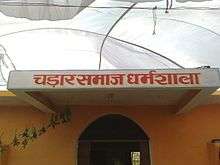Chadar
- For the outer garment worn by women, see Chador.
Chadar Kshatriya (Hindi: चडार/ चढार) is a Hindu caste found in central regions of India.
These are known to be Chandra Vanshi Kshatriya. Only few thousand Chadar people currently exist and the number of Chadars is continuously decreasing. Thus, they are moving towards minority community. The Chadar have customs and lifestyle like tribes.
Surname and pronunciation
Chadar (Hindi:चडार) is commonly pronounced as Cha_daa_r.
Chadar kshatriya were known for very aggressive attacks (चढाइ) on enemy. The Chadar / chadhar (चडार or चढार) surname originated from the word Chadhai (Hindi: चढाइ) which means Attack for which Chadars were known.
Other Surnames used by Chadars
The other names used by people of this caste are:
- Athya
- Sakle
- Atthaya
- Charar
- Athiya
- Chandel
- Pawar
- Soniya
- Chidar
- Vilye
- Gehlot
- Sandariya
- Sundre
- Ghangere
- Verma
- Sutrakar
- Charul
- Thakur
- Pushkar
- Chandravansi
- Gohiya
- Sarawat
- Chadhar
- Bunkar
- Katiya
- Amalkaar
- Bhartiya
- Binakiya
- Bisrotiya
- Beliya
- Bachheliya
- Barha
- Brahmaniya
- Hanumantiya
- Hardiya
- Ghuraiya
- Magariya
- Ghure
- Sure
- saad(Salad)
- Saanvar
- Vinayak
- Tameshwari
- Naga(Naag)
- Kumeriya
- Magria
- Atthaya
Origin
The origin of Chadar is from Chittorgarh Rajasthan and their near regions like Kota, Bundi, etc. The Chadars are known to be descendants of Chandela's. From the ninth century to the 13th century, the Chandelas ruled over central India. Their first capital city was Khajuraho, which was later shifted to Mahoba. They are regarded to be Chandravanshi; i.e., the descendants of the Som (Sanskrit literal meaning: moon). The Chandela are a Rajput clan found in Rajasthan, Haryana, Uttar Pradesh, Madhya Pradesh, a dynasty, who ruled much of the Bundelkhand region of central India for long periods between the 10th and the 13th centuries AD. The Chandela dynasty is famous in Indian history for sculptures at temples of Khajuraho which is now a world heritage site.
Muslim invasions
After about two centuries of obscurity a notable Chandela ruler Keerat Pal Singh rose to power and re-established his domain over Kalinjar and Mahoba. His illustrious daughter Durgavati was married to Gond ruler Dalpat-shah of Garh Mandla (near Jabalpur) in 1543 A.D. Later, Keerat Pal Singh battled bravely with Sher Shah Suri, while defending Kalinjar fort in 1545. Sher Shah, however, captured the fort after a prolonged fight but was killed in an explosion while directing final assault on the fort.
The account of Rani Durgavati's deeds is most glorious. She administered her territory admirably well after the death of Raja Dalpat Shah and in 1564 A.D. gallantly resisted the unprovoked aggression of Mughal Emperor Akbar, whose general Asif Khan attracted Garh Mandla to annex Rani's territory. The Rani gave a brave fight but lost her life in the battle-field. The aggression of Akbar on women rulers like Durga Wati and Chand-bibi tarnish his image as a liberal ruler.
There ends the saga of brave and valorous, patron of art and culture, rich and devout kings of the Chandela dynasty who ruled over central India for half a millennium. Their kingdom decreased and expanded in size in accordance with the velour and fortune of the individual ruler. But the most important objects which nearly every king left behind are the magnificent and exquisitely carved temples, thereby engraving their names in history in the golden letters.
Geographical distribution
This caste is found mainly in districts of Madhya Pradesh, Chhattisgarh, Uttar Pradesh and Rajasthan.
Welfare Organization of Chadars
The welfare organisation of Chadar is registered as society called Akhil Bhartiya Chadar (Chidar) Kshatriya Samaj Society (Hindi:आखिल भारतीय चडार (चिडार) क्षत्रिय समाज समिति). This society oragnises Annual Youth Festival at different locations of Madhya Paradesh with a view to encourage marriage within caste. This event is known as Chadar Samaj Yuwak Yuwti Parichay Sammelan. It has also built a Hanuman Temple at the bank of holi Narmada river at Jabalpur.

A free of cost lodge (Dharmshala) has also been built by Chadar Society at Bhedaghat (tourist place at the bank of Narmada river), Jabalpur.


The Hanuman Jayanti is celebrated by Chadars at Hanuman Temple Bhedaghat, Jabalpur every year.